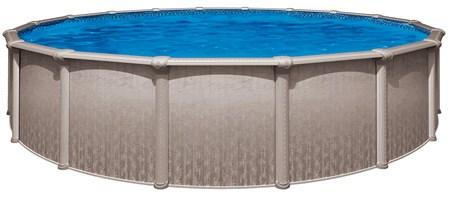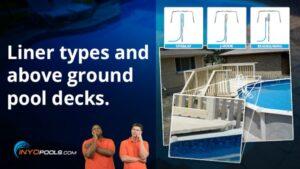It’s not as big a question as it was six or eight years ago, but I still get a fair amount of people asking about aluminum above ground pools. The main reason anyone would consider an aluminum over a steel above ground pool is to avoid rust. This is definitely true as aluminum won’t rust. Rust is a term that is used only for the oxidation of iron and aluminum has no iron. It will corrode, though, so there’s not much to gain in getting an aluminum pool, but it’s worth going over the pros and cons just in case your heart is set on getting one.
If you don’t want to read this whole article just to get my opinion, then no worries. I’ll give it to you right now. In the general sense, aluminum pools are not worth the extra cost. Now, if you have the time to find out why, read on.
The Different Types of Aluminum and Steel Above Ground Pools
There are about six variations of aluminum and steel pools and they each have pluses and minuses. Let’s go over them. Shall we?
I. All aluminum pool
This is an above ground that has every part of it made of aluminum. The wall, top and bottom tracks, all the connectors, stabilizer bars, top rails, uprights, and top caps are 100% aluminum. These pools are usually nicer than average and are a lot more expensive.
II. All steel pool

All steel pools aren’t as common as before, but there are still quite a few of these manufactured. They have steel walls, tracks, connector plates, uprights, stabilizer bars, top rails, and top caps. These are mostly the lower-end models of above grounds.
III. Part aluminum, part steel pool
There are some variations here, but mostly these pools will have aluminum top rails and caps and the rest is steel. These aren’t too bad, because they have steel walls. They can still be quite a bit more expensive, though.
IV. Part steel, part resin (aka hybrid above ground pools)

This is the most popular type of above ground today. Almost all of them will have steel walls, but there are various combinations of resin and steel parts. Some will have resin bottom tracks and/or resin connector plates. Some will have resin uprights with steel bottom tracks. Most of these, though, come with resin top rails and caps with everything else being made of steel. Overall, this is my favorite combination.
V. Part aluminum, part resin
This isn’t a super common type, but I do see these. They mostly have aluminum walls, top connectors, and stabilizer bars combined with resin top rails. These are not my favorite as they have aluminum walls and are still pricey for what you get.

VI. All resin pool
I hear this term a lot and it’s not accurate. Resin material is plastic and is in no way strong enough to hold the pool water. So, an all resin pool still has to have a wall made of metal. And they almost all have steel walls. So, an all resin pool really is a pool that has every part of it made of resin, except the wall.
Also, some pools that are called “all resin” will still have some steel parts like connector plates and steel screws. The only model that comes to mind that is truly all resin (except of course the wall) is one called the Matrix by Wilbar.
VII Extruded aluminum wall pool
This type of above ground has quite a different wall from the others. The other pool walls are one continuous piece while this one comes in sections that interlock together. The wall sections are made of extruded aluminum which makes them stronger and thicker. The extra thickness is very important in that this wall could never corrode enough to make the wall fail and not hold the water of the pool.
This pool is considerably more expensive than the others and the only real difference is the wall. Manufacturers sell this as a semi in-ground pool and that’s why it has that fancy wall system. The wall is strong enough not to cave in when the pool is empty and in the ground. This is nice and true, but I’m not sure if it’s worth the extra cost as a regular walled above ground pool goes in the ground too and usually with few issues.
VIII. Semi in-ground pool
I hear this term more and more and it’s slightly misused. First off, there really is a thing called a semi in-ground pool and that’s not at all what I’m talking about here. A real semi in-ground pool is closer to an in-ground vinyl liner pool than an above ground in price and structure. A more accurate term for what I’m discussing is a “semi in-ground above ground pool”.
The term semi in-ground is used for above ground pools that can go partially in the ground. I say this is a misused term, because all above ground pools can go partially in the ground. The fact is the only real “semi in-ground above ground” pool that I know of is the above-mentioned extruded aluminum wall pool. Interestingly, I have installed the extruded aluminum pool above the ground as much as I have installed it semi in the ground.
Nice List, Dude, but Should I Get Aluminum or Steel?
The above-mentioned types of pools have three kinds of walls – steel, aluminum, and extruded aluminum. If I’m strictly speaking of the wall itself, then I don’t see any advantage to getting the regular aluminum wall for your above ground pool. They are flimsy and are too thin to stop corrosion from eventually compromising the wall’s integrity. Regular aluminum walls are bad for installing the pool halfway in the ground too as they are not at all rigid and thus have a greater capability for a cave-in when the pool is empty.
Extruded aluminum walls are really strong and will last forever, but the price difference is really big. Unless you have enough money for it not to matter, I don’t recommend the extruded wall pool. Steel walls is my choice. Most above grounds have steel walls so you’re good there.
So, now that I have established that I prefer the wall of the pool to be steel, what about the other parts? I have had good luck with other parts of the pool being aluminum. Uprights and top rails made of aluminum seem to hold up better than steel ones for sure. I do prefer resin top rails over all others as they usually hold up better than the metal ones. I also prefer the bottom track and connectors to be made of steel too as aluminum can be too light and flimsy and resin connectors can crack.
When buying a hybrid above ground, there is almost no way to find out which parts are made of what and it may not matter much anyway. For me the best combination is for a pool to have a steel wall, steel bottom track, steel or aluminum bottom connectors, steel or aluminum top connectors, steel top stabilizer bars, steel or aluminum uprights, and resin top rails and caps.












Leave a Reply